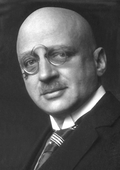Haber process
Haber Process is a method of synthesizing ammonia from hydrogen and nitrogen. Developed by Fritz Haber in the early 20th century, the process is important in the large-scale production of fertilizers and explosives.
History[edit]
The Haber process was developed in the early 20th century by German chemist Fritz Haber. Haber was awarded the Nobel Prize in Chemistry in 1918 for this development. The process was later commercialized by Carl Bosch, leading to its widespread use in the industrial production of ammonia.
Process[edit]
The Haber process involves the direct synthesis of ammonia from its elements, hydrogen and nitrogen. The reaction is carried out at high temperatures and pressures, and is typically facilitated by an iron catalyst.
The overall reaction is: N2 + 3H2 ⇌ 2NH3
This reaction is exothermic, releasing heat and thus favoring the formation of ammonia at lower temperatures. However, the reaction rate is slow at lower temperatures, so the process is typically carried out at a high temperature to increase the reaction rate.
Industrial significance[edit]
The Haber process is of great industrial significance as it allows for the large-scale production of ammonia. Ammonia is a key ingredient in the production of fertilizers, which are essential for modern agriculture. It is also used in the production of nitric acid, which is used in the manufacture of explosives.
Environmental impact[edit]
While the Haber process has greatly increased the availability of fertilizers and thus contributed to increased agricultural productivity, it also has significant environmental impacts. The process requires large amounts of energy, typically derived from fossil fuels, contributing to greenhouse gas emissions. Additionally, the widespread use of nitrogen-based fertilizers has led to increased nitrogen levels in water bodies, contributing to eutrophication and the degradation of aquatic ecosystems.
See also[edit]
|
|
|
Haber process[edit]
-
Fritz Haber
-
Carl Bosch (1908)
-
Ammonia Reactor BASF
-
Steam Methane Reforming and Water Gas Shift
-
Ammonia Reactor 1913 Oppau
-
Heterogeneous Catalysis
-
Haber-Bosch Process Diagram
-
Ammonia Reactor Diagram
-
Catalyst for Ammonia Synthesis
-
Potential Energy Diagram for Ammonia Synthesis
-
Severnside Fertilizer Works
Ad. Transform your life with W8MD's Budget GLP-1 injections from $75


W8MD offers a medical weight loss program to lose weight in Philadelphia. Our physician-supervised medical weight loss provides:
- Weight loss injections in NYC (generic and brand names):
- Zepbound / Mounjaro, Wegovy / Ozempic, Saxenda
- Most insurances accepted or discounted self-pay rates. We will obtain insurance prior authorizations if needed.
- Generic GLP1 weight loss injections from $75 for the starting dose.
- Also offer prescription weight loss medications including Phentermine, Qsymia, Diethylpropion, Contrave etc.
NYC weight loss doctor appointmentsNYC weight loss doctor appointments
Start your NYC weight loss journey today at our NYC medical weight loss and Philadelphia medical weight loss clinics.
- Call 718-946-5500 to lose weight in NYC or for medical weight loss in Philadelphia 215-676-2334.
- Tags:NYC medical weight loss, Philadelphia lose weight Zepbound NYC, Budget GLP1 weight loss injections, Wegovy Philadelphia, Wegovy NYC, Philadelphia medical weight loss, Brookly weight loss and Wegovy NYC
|
WikiMD's Wellness Encyclopedia |
| Let Food Be Thy Medicine Medicine Thy Food - Hippocrates |
Medical Disclaimer: WikiMD is not a substitute for professional medical advice. The information on WikiMD is provided as an information resource only, may be incorrect, outdated or misleading, and is not to be used or relied on for any diagnostic or treatment purposes. Please consult your health care provider before making any healthcare decisions or for guidance about a specific medical condition. WikiMD expressly disclaims responsibility, and shall have no liability, for any damages, loss, injury, or liability whatsoever suffered as a result of your reliance on the information contained in this site. By visiting this site you agree to the foregoing terms and conditions, which may from time to time be changed or supplemented by WikiMD. If you do not agree to the foregoing terms and conditions, you should not enter or use this site. See full disclaimer.
Credits:Most images are courtesy of Wikimedia commons, and templates, categories Wikipedia, licensed under CC BY SA or similar.
Translate this page: - East Asian
中文,
日本,
한국어,
South Asian
हिन्दी,
தமிழ்,
తెలుగు,
Urdu,
ಕನ್ನಡ,
Southeast Asian
Indonesian,
Vietnamese,
Thai,
မြန်မာဘာသာ,
বাংলা
European
español,
Deutsch,
français,
Greek,
português do Brasil,
polski,
română,
русский,
Nederlands,
norsk,
svenska,
suomi,
Italian
Middle Eastern & African
عربى,
Turkish,
Persian,
Hebrew,
Afrikaans,
isiZulu,
Kiswahili,
Other
Bulgarian,
Hungarian,
Czech,
Swedish,
മലയാളം,
मराठी,
ਪੰਜਾਬੀ,
ગુજરાતી,
Portuguese,
Ukrainian













